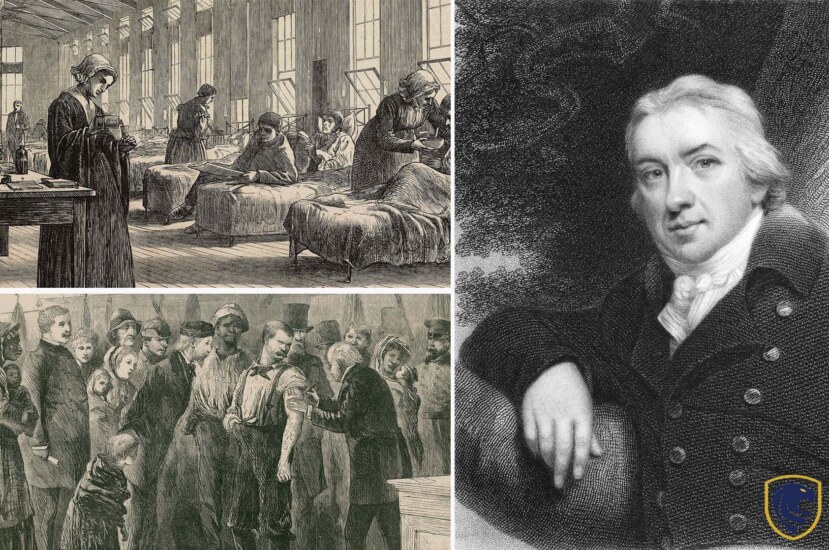The development of the vaccination was a success for all human kind as the vaccination has saved millions of lives. The vaccine developed for smallpox was the first vaccine. Moreover, the discovery of first vaccine was followed by vaccines for other infectious diseases like Polio, Tetanus Flu (Influenza) Hepatitis B, Hepatitis A, Rubella, Hib, Measles, rabies etc.
Smallpox
From the times of antiquity, smallpox Killed people of all walks of life, male female, the young and the old. At least one in three of infected people succumbed to the illness. Smallpox cases can be traced back to as early as 1350BCE. In the studies carried out, smallpox cases have been found in Egyptian mummies.

Smallpox
Symptoms
The smallpox brings about hideous symptoms as the whole body gets covered with fluid-filled lesions. Apart from that an infected person would get high fever, vomiting and mouth sores. Also, an infected person can die all of a sudden, generally within two weeks of infection. The impairments of the disease that the survivors get due to smallpox can be permanent. For instance, infertility and blindness can be cited.
Dr. Edward Jenner
Dr. Edward Jenner was an English doctor. He was born in an English countryside called Berkeley, in Gloucestershire, England. He was born on 17th May, 1749 and his father was a clergyman. Moreover, his school was Grammar school. It was a period that the medical knowledge was gained mostly from apprenticeship rather than the academic work. When he was thirteen he trained under a surgeon in his neighborhood. During the eight years that followed, he acquired thorough knowledge of medical and surgical science. Finally, he concluded his training at 21 years. Then , he started training at St. George’s hospital, under John Hunter who was an eminent surgeon, anatomist, biologist and an experimentalist.

Dr. Edward Jenner
Jenner received training and experience in biology and clinical surgery. He went back to Berkeley after a sojourn in London from 1770 to 1773. Moreover, he became a talented and popular medical practitioner. He got the reputation for the discovery of first vaccination.
Smallpox during Dr. Edward Jenner’s era
Smallpox was a very prevalent disease in 18th century. The only treatment was Variolation which was passed down from ancient times.
Variolation in ancient times
This practice which dates back to 200BCE had been extensively used in Asia and Africa. In a variolation, a little quantity of substance is entered into a healthy person. It leads to a slight sickness and the mortality rate is low than that of natural infection. Further, in mid 1500s, in China variolation which was known as insufflation was used in which drained smallpox scabs blown into the person’s nostril using a pipe. In India substance from smallpox was entered into healthy children through a needle. Also, the slaves of west African origin used this technique for a prolonged time period. The wife of British ambassador to Turkey, Lady Mary Wortley Montagu observed the practice in the Ottoman empire. She introduced the practice to Europe in 1721.

Variolation in ancient times
First Vaccination
In May 1996, Dr.Edward Jenner carried out the world’s first vaccination. A principle similar to variolation was applied in developing the vaccine, but the source of virus was cowpox which was less perilous.

First Vaccination
Dr Edward Jenner’s Experiment
Dr.Jenner observed that some milkmaids who contracted cowpox disease were resistant to smallpox disease even though they were in close contact of the people with the fatal disease .
So, his first experiment on vaccination was done on eight-year-old boy called James Phipps. He got cowpox substance from a local milkmaid and administered that to the boy. Initially the boy fell ill for several days. But he fully recovered. So, in July 1796, that is after two months of administration of cowpox virus, Dr.Jenner entered substance collected from a human smallpox sore into the boy. He was not affected from smallpox virus and he was in full strength and vigour.

Dr Edward Jenner’s Experiment
He named his finding vaccination and proved that it’s better and desirable to variolation when safety and effectiveness are taken into account. His colleagues and authorities were convinced that the vaccination is a better option when they studied Jenner’s experiments which were in detail.
Obstacles and criticism
Jennifer was accused for using a small kid for his experiment. And he got criticism from the church upon injecting humans with animal matters, as it was considered an act against the god. The doctors who made a lucrative business out of variolation were against the vaccination. Because they knew vaccination would overtake variolation and they would lose their source of income. And rumors were spread among people that vaccination would turn the vaccinated people into cows.

Dr Edward Jenner’s Experiment Obstacles and criticism
Success of Vaccination
Despite the criticism, extensive research was carried out on the vaccination. By 1801 it was proved that vaccination was effective.
Worldwide Distribution
The vaccination was spread to other continents as well. The vaccines were administered on arm. In 1840s and 11850s obligatory vaccination programs were enforced in the United Kingdom, the United States and in other countries. Having a smallpox vaccination certificate was compulsory when travelling.

Worldwide Distribution
Outcome
By the time of 1900s, some of the European parts were successful in eradicating the smallpox virus. Yet the colonized countries were hard hit by smallpox at the time. Each year there were reports of over 2 million deaths. In another 50 years the globe came in line with the fight against the disease.
Meantime research on vaccination was done across the world to find better and effective vaccine. In 1950s there were improvements in technology. The heat-stable freeze-dried smallpox vaccines came up. They could be stored without refrigeration. This drive of vaccination resulted in eradication of smallpox in western Europe, North America and Japan.
But in other parts, the diseased continued to remain due to lack of a large-scale coordinated international program.

Worldwide Distribution of the vaccine
WHO Efforts to eliminate the disease
In 1958 the World Health Assembly started a progra to eradicate smallpox at global level or to bring down the cases to zero level. Also, they worked on to ensure prevent any risk of re-emergence. This eradication program included childhood immunization programs, and mass vaccination. The member states of WHO offered support and technical assistance. So, the vaccination program turned out successful, as many countries saw progress in their situation.

WHO Efforts to eliminate the disease
Intensified Smallpox Eradication Program
In 1967 an intensified vaccination program was carried out in order to eradicate the disease, so more effort was put to the endeavor. Soviet Union’s freeze-dried vaccine put the ground for the eradication of smallpox disease in Eastern Europe, China and India.
Thousands of the health workers and local surveillance officers committed themselves for the cause, so that even countries with rudimentary health system made big progress. It was WHO that played the pivotal role. All nations were striving for the same cause supporting each other. In this fight against the common enemy, even the rival states the Soviet Union and the United Stated worked together towards the common goal. The whole world demonstrated impressive unity in eradicating the smallpox.
For example South West India was hard-hit in 1970 having over 1300 cases and 123 deaths. To aid India international health personnel’s were stationed. They were tasked with identifying contacts with recent cases, and vaccinate them. Also, they went house to house in search of contacts of virus. They were succeeded in eradicating the disease within weeks.

Intensified Smallpox Eradication Program
Expenditure of the Programme
The outlay for the vaccination program was nearly US$300 million. The countries like Britain, Canada, Cuba, Franc, Soviet Union, and the USA provided WHO with free vaccines.
Over the time vaccination techniques were improved. Moreover, higher quality freeze-dried vaccines were introduced. Bifurcated needle which is easy to administer the dose was introduced. These advancements contributed to the efforts of eradication program.

Complete Eradication
Complete Eradication
Finally, hard work of WHO, national health offices and scientists bore fruits as smallpox was eradicated in South America, Asia and Africa in 1971, 1975 and in 1977 respectively. It was in 1980 that the WHO proclaimed the complete eradication of smallpox. Further, the discovery of vaccination saved people from death, blindness, deformation. And vaccination continues to save humankind from other diseases like rabies, rubella etc.




